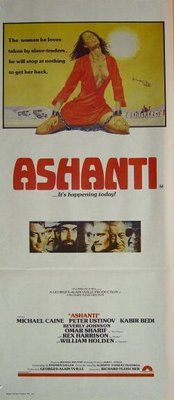 Cast: Michael Caine (Dr David Linderby), Peter Ustinov (Suleiman), Kabir Bedi (Malik), Beverly Johnson (Dr Anansa Linderby), Omar Sharif (Prince Hassan), Rex Harrison (Brian Walker), William Holden (James Sandell), Zia Mohyeddin (Djamel), Winston Ntshona (Ansok), Tariq Yunus (Faid), Tyrone Jackson (Dongaro), Akosua Busia (The Senofu Girl).
Cast: Michael Caine (Dr David Linderby), Peter Ustinov (Suleiman), Kabir Bedi (Malik), Beverly Johnson (Dr Anansa Linderby), Omar Sharif (Prince Hassan), Rex Harrison (Brian Walker), William Holden (James Sandell), Zia Mohyeddin (Djamel), Winston Ntshona (Ansok), Tariq Yunus (Faid), Tyrone Jackson (Dongaro), Akosua Busia (The Senofu Girl).Crew: Richard Fleischer (director), Georges-Alain Vuille (producer), Stephen Geller (writer); Michael Melvoin (music); Aldo Tonti (cinematography); Ernest Walter (editor), Mario Chiari, Aurelio Crugnola and Kuli Sander (art direction).
Synopsis: Doctors David and Anansa Linderby are travelling around West Africa inoculating people in villages for the World Health Organisation. Anansa’s ancestors were members of the Ashanti tribe, but she was educated in America before marrying her white English husband. Anansa is abducted by slave traders led by a ruthless Arab, Suleiman. David pursues Suleiman’s caravan of slaves for three thousand miles across Africa to the Red Sea. He is aided by Malik, an Arab who has sworn vengeance after Suleiman abducted and sold Malik’s family as slaves. The duo finally confront Suleiman, but he has already sold Anansa into slavery. He agrees to say more only if Malik swears not to slay him. Suleiman says Anansa was bought by an Arab royal, Prince Hassan, who has already set sail. David murders Suleiman. The doctor and Malik get aboard the prince’s ship and rescue Anansa, but Malik is killed by the prince’s bodyguards…
+++++++++++++++++++++++++++
Ashanti was based on the 1976 novel Ebano by Alberto Vasquez-Figueroa about slave trading in Africa during the 1970s. The film’s production was troubled, with the original director, female lead and several crew members leaving after the first week. Work resumed a fortnight later, with the film shot on location in Kenya, Israel and Sicily, with the Sinai Desert doubling for the Sahara. ‘Of the films I’ve made Ashanti was by far the hardest,’ Caine told the Sunday Express in 1978. Filming took place in 130 degree heat. ‘The Egyptians can have the Sinai Desert back as far as I’m concerned. The camels were fainting from the heat and they still expected me to act.’
Two years later Caine told Film Comment magazine Ashanti was the only film he’d ever made just for the pay cheque. He was moving to Hollywood and needed cash. ‘I did Ashanti solely for the money, and I have never been so unhappy in my career. I swore I would never do it again, no matter how broke I was. That was the one and only time. Though I did what I could with the part, I hated and loathed ever second on it.’
The BBFC gave the film an AA Certificate, allowing anyone aged 14 or above to see it. Neither critics nor the public were impressed when it was released in Britain early in 1979. The Council for the Advancement of Arab-British Understanding was incensed by the movie, issuing the following statement: ‘Ashanti is one of the most virulent examples of Israel’s supporters attempting to prejudice Western opinions against the Arabs.’ In the US, Ashanti was released in April 1979 with an R rating from the Motion Picture Association of America (MPAA). Seven years later the film crept out on video in the UK, reclassified as a 15. It was re-released on VHS in 2000, but became available on DVD in 2006.
Reviews: ‘Absurd and rather unattractively brutal adventure story…’ – Halliwell’s Film & Video Guide
‘It is a toss-up as to whether Ustinov or the camels have the best lines’ - The Guardian
Verdict: In his autobiography, Caine calls Ashanti the worst, most wretched movie he ever made. He certainly seems to have had a terrible time during shooting, but there are worse pictures in his long career. This film is blander than a blancmange and twice as lifeless. Geller’s script never rises about routine, introducing characters with potential and then dismissing them minutes later. As the slave trader Ustinov gets all the best lines and hams like crazy, but Caine merely alternates between anger and frustration. A particular low point is when he spends two minutes trying to get on a camel in what is presumably meant to be a comic interlude. Fleischer’s flat, flabby direction leaves you begging for the end, but the finale is perfunctory at best. Ashanti is best watched with the fast forward button close to hand – or not watched at all.
No comments:
Post a Comment